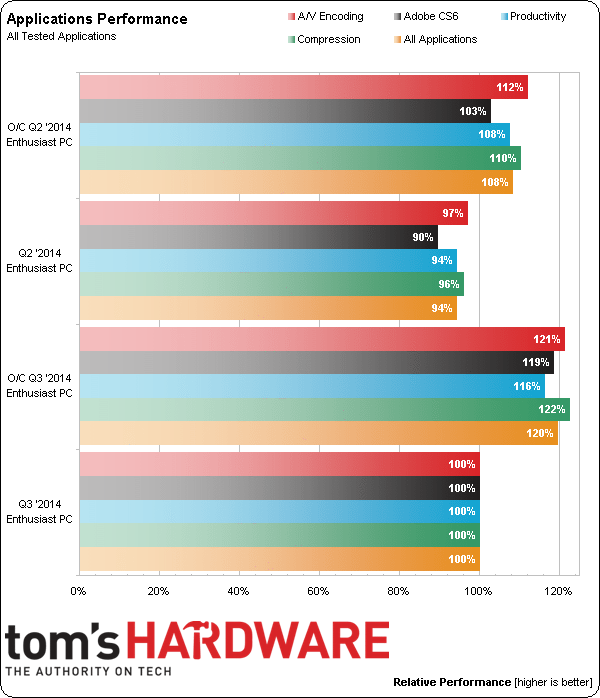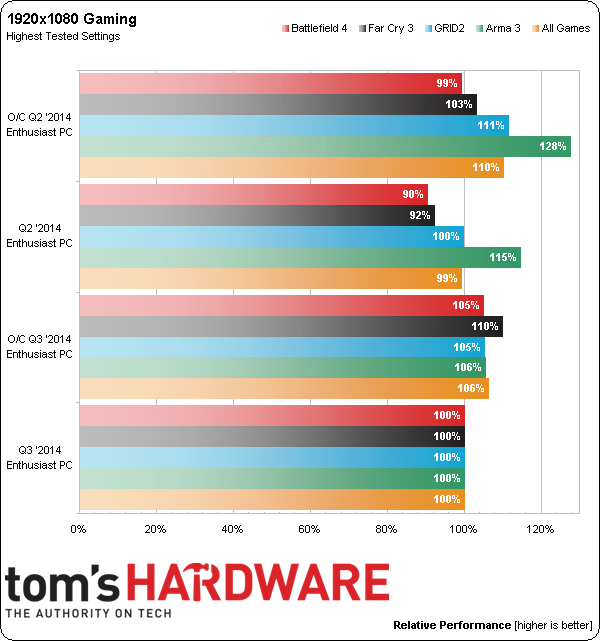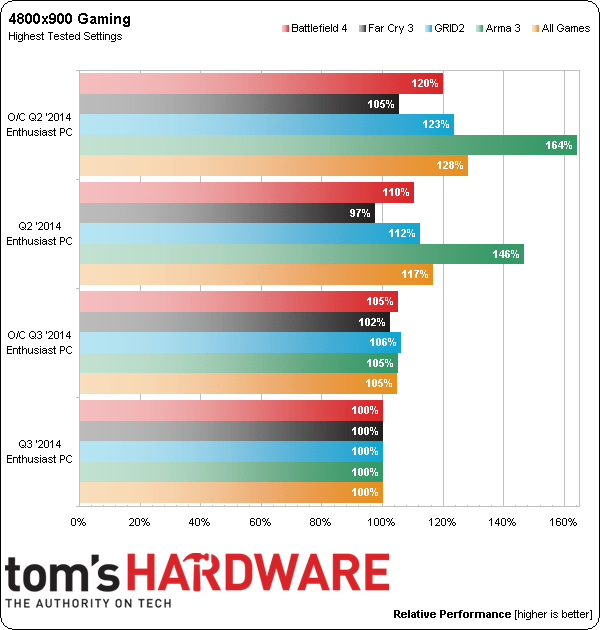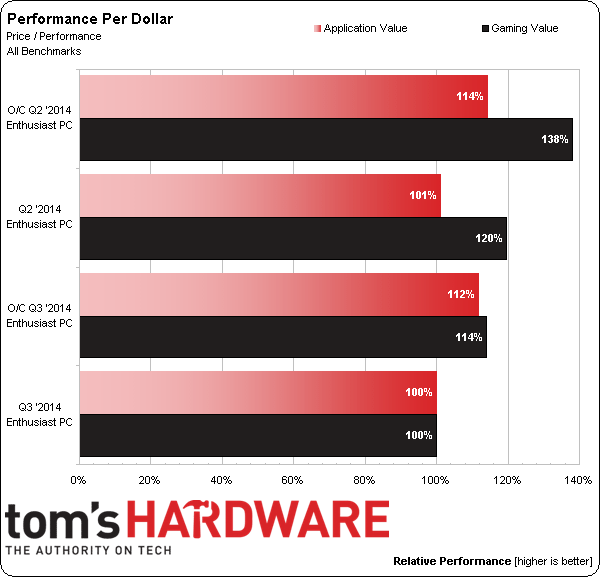System Builder Marathon Q3 2014: Mainstream Enthusiast PC
Q3 2014 Mainstream Enthusiast PC Under $1300 Verdict
In this third quarter of 2014 we put a strong focus on overclocking. The cost of premium cooling forced us to compromise in the graphics department, though, with a cheaper graphics card. Of course, if the GeForce GTX 970 was for sale when we chose parts for this build we could have had our cake and eaten it, too.
Alas, that is not the case. Let's focus on application performance, then, and see if the higher-clocked Core i5-4690K has won us significant ground over the Core i5-4670K in our Q2 enthusiast build:
It's clear that the Core i5-4690K/Noctua NH-D14 cooler/G.Skill 2400 MT/s RAM had an affect on performance, but it's not as dramatic as we'd hoped. If you're looking for multi-threaded workstation performance you'd probably be better off investing in a Core i7 processor and a $30 aftermarket cooler. Of course, overclocking is like climbing a mountain: people do it because it is there. For an enthusiast who considers the persuit of higher clock rates its own reward, there are worse ways to spend your money. Indeed, my experience with this particular install was interesting and fun, despite (perhaps even because of) the physical modifications I had to make to the RAM.
Out of curiosity, how did the GeForce GTX 770 fare against the Radeon R9 290 in the previous build?
At 1920x1080, the GeForce GTX 770 has nothing to apologize for. It really held it's own against the newer Radeon R9 290, even beating it in some titles. Of course, when the resolution is raised to triple-monitor 4800x900, the Radeon's shader and bandwidth advantages kick in and it takes a lead overall, but it's not as high as we expected. The better platform really helped it stay in the game.
When price vs. performance is compared, the new build doesn't look as attractive as the Q3 enthusiast system. There are a couple reasons for this, but primarily it's due to the fact that overclocking equipment such as high-end cooling and memory comes at a price premium, forcing us to downgrade our graphics card. In addition, we added an SSD because it's almost a necessity: once you've booted to one, you can't go back.
While our overclocking experiment was a success in the sense that it got us farther than $30 CPU coolers and value RAM have taken us in the past, this result only validates our usual formula for a solid midrange system: invest in a Core i5, pair it with a cheap and effective cooler, add 8 GB of reasonably priced RAM, and spend the rest on the best graphics card you can afford.
Get Tom's Hardware's best news and in-depth reviews, straight to your inbox.
I look forward to seeing how this PC compares with the budget and high-end PCs put together by Paul Henningsen and Thomas Soderstom. We'll find out how this enthusiast build compares from a value perspective in our day 4 value comparison this Friday.
Current page: Q3 2014 Mainstream Enthusiast PC Under $1300 Verdict
Prev Page Power And TemperatureDon Woligroski was a former senior hardware editor for Tom's Hardware. He has covered a wide range of PC hardware topics, including CPUs, GPUs, system building, and emerging technologies.
-
gamebrigada Not sure why you would go with AsRock... I've seen so many failed motherboards from them after a few months of use... Friend of mine is on his 4th swap from them, and is beyond tired of swapping with them, the current one at least has issues that he can work around... with a usb to ethernet adapter....Reply -
mlga91 Personally, i'd get a cheaper case and put a 970 on there, looks for the cost of performance doesn't seems too wise for me.Reply -
DynamoNED Reply14242198 said:Personally, i'd get a cheaper case and put a 970 on there, looks for the cost of performance doesn't seems too wise for me.
While I'd agree on the cheaper case, the 970 wasn't an option since they hadn't been released when they were buying parts for this quarter's SBM.
From Page 3 of the article: "The GeForce GTX 970 launched last week wasn't available (or even public information) back when we ordered the pieces for this build. So, I needed something cheaper than the Radeon R9 290 that wouldn't sacrifice gaming performance. Under $300, the best option was Nvidia's GeForce GTX 770."
Obviously, today the 970 would be a much better choice, but that option didn't exist when this build was purchased. -
realibrad @ mlga91Reply
Good job. There is always that guy who does not read the article when it explains why the brand new card was not used, because it was not an option at the time of the review.
So congrats on being that guy this time. It only took 3 posts to get there. -
de5_Roy an ssd and a cm haf case in this build. that should prevent the rages, gasps and disapproving gazes from the last quarter. ;) really though, a o.c. oriented pc should have parts built for speed and this pc has them.Reply
on the last page:
When price vs. performance is compared, the new build doesn't look as attractive as the Q3 enthusiast system.
may be you meant the Q2 enthusiast system. imo, yea, the q3 build doesn't seem as attractive as the q2 one. i think that one could add the ssd from this build and still be the better pc.
i wonder if you guys would build an fx8350/8320 pc as an alternative build at this price range for the ongoing overclocking theme. -
Onus The PSU received a Golden Award at HardwareSecrets, and it did mostly well on other sites as well, although at least three noted the presence of Samxon capacitors. They don't appear to be "GF" series though, which supposedly are the really bad ones.Reply
I'd like to know more about the thickness / flexibility of the ASRock mobo. Otherwise, I don't think I have any niggles over performance-related parts. -
g-unit1111 Reply14242123 said:Not sure why you would go with AsRock... I've seen so many failed motherboards from them after a few months of use... Friend of mine is on his 4th swap from them, and is beyond tired of swapping with them, the current one at least has issues that he can work around... with a usb to ethernet adapter....
I've never had any problems with Asrock and I'm on my second Asrock board. -
Onus Although some of them are thin and uncomfortably flexible, I've also not had any ASRock mobos die on me, except one likely killed by heat. I have read mixed comments on them, although most reviews tend to be positive.Reply




